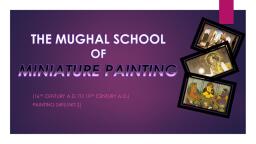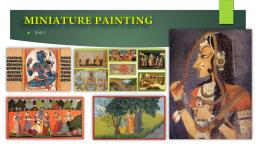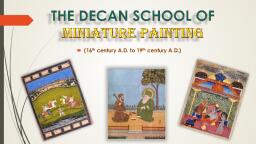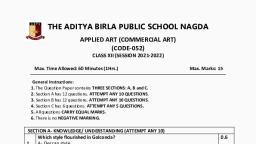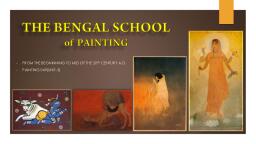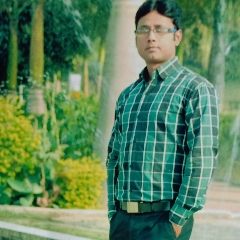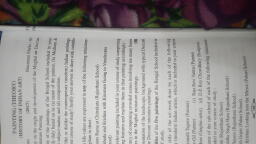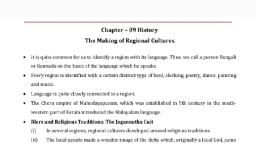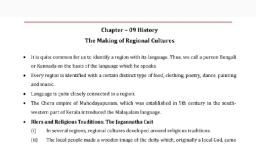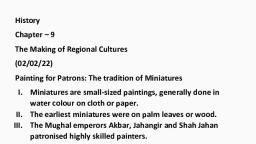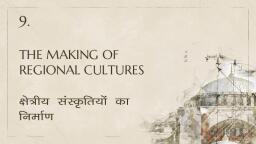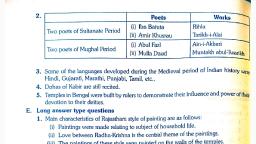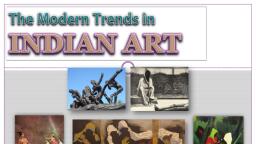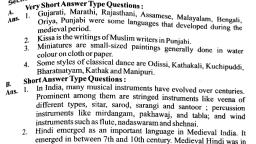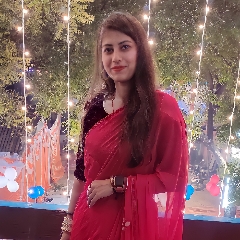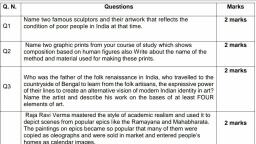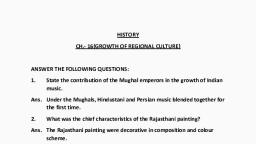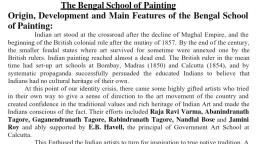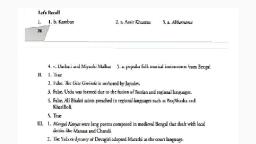Page 3 :
1. Diverse Sub-matter: The illustrated subject matter can be broadly, divided into the following three categories :, (i) Religious paintings: Ramayana, Mahabharata, Shiva-Parvati,, Durga Saptasati , Bhagwat Puran, etc., (ii) Romantic: Nayak-Nayika Bheda, Geet-Govind, Bihari Satsai, and Ragmala painting., (iii) General : Royal Court scenes, Portraits, general life,, Bharahmasha, Festivals and Fairs., 2. Linear Beauty: Rhythmic lines have been depicted which are, smooth in nature and are very fine. The drawings of eyes are very, fine and worth praising., 3.Colour schemes : Primary colours have been used. some colours, are like pink, mauve, Gray and green have also been used. Golden, colours is used in large scale. The red coloured border have been, used having an influence of Mughal style. The colours are strong, and contrasting. in the garments and ornaments, golden and silver, colours have been used .The lightening has been shown through, silver colour.
Page 4 :
4. Garments : Choli, Lehanga and TransparentOdhanis have been, worn by women. Male have been shown in Pyjamas, Turban and, Angrakhas., 5., , Depiction of Nature : Trees, clouds, jungles, mountains,, foliage, rivers, aquatic birds etc. have been depicted, beautifully. The rainy season and lighening effects have been, nicely painted., , 6., , Perspective : In spite of having no proper perspective, the, Pahari paintings appeal to us., , 7., , Romantic Scenes : Many romantic scenes have been found, in Pahari style. Krishna symbolizes ‘God’ (Nayak) and Radha, symbolizes ‘Soul’ (Nayika) in many of these painting.
Page 6 :
, , , , FEATURES OF BASOHLI SCHOOL :, 1. In Basohli, use of strong brilliant colours reinforces (bright red, yellow ,green etc.) its spirited, approach to the subject matter ., 2. Figures with distinctive features such as fish shaped elongated eyes or large expressive lotus shaped, eyes. round chins, prominent nose oval face, receding foreheads, powerful body with a pleasant, plumpness present an idealistic body symmetry and lend distinction to female figure., 3. clarity of design and wonderful effect is created by the mixture of blue and yellow, red and, blue, gray and brown colour which enhance the beauty of the painting., 4. The shining bright fragment of beetle wings imitating emerald in jewellery and droplets of, thick white paint giving the effect of real pearl are Basohli trademark.
Page 7 :
❑, , The first quarter of the eighteenth century saw a, complete transformation in the Basohli style, initiating the, Guler–Kangra phase. This phase first appeared in Guler, a, high-ranking branch of the Kangra royal family, under the, patronage of Raja Govardhan Chand (1744–1773)., , ❑ Guler artist Pandit Seu with his sons Manaku and Nainsukh are attributed with, changing the course of painting around 1730–40 to a new style, usually,, referred to as the Pre–Kangra or Guler–Kangra kalam. This style is more, refined, subdued and elegant compared to the bold vitality of the Basohli style., , ❑ At Guler, a number of the portraits of Raja Goverdhan Chand of Guler, were executed in circa 1750 A.D. in a style having close affinity with, the portraits of Balwant Singh of Jasrota., , ❑ The finest group of miniature done in the Pahari region is represented by, the famous series of the Bhagwat, the “Geeta Govind” that the “Bihari, Satsai” the “Barahmasa” and the “Ragmala” painted in 1760 A.D. The, exact place of the origin of these series of painting is not known.
Page 8 :
Kangra paintings have been considered one of the best miniature paintings, of the world. This school was born in 18th century as a mixture of, Rajasthani and Mughal style. Painting in the Kangra region blossomed, under the patronage of a remarkable ruler, Raja Sansar Chand (1775–1823)., ❑ Kangra School flourished due to devotion and efforts of the refugee artists, of Aurangzeb s court and local folk Pahari artist of Guler and Chamba., Guler Nurpur and Tira- Sujanpur were main centers of Kangra school., ❑, , ❑, , :, , 1. Along all Rajput paintings, the paintings of Kangra have a status of their own, , because, of their maturity, fine sense of beauty, artistic and poetic, sensibility, rhythmic lines and colour combination which is soft and mellow., 2. Only in Kangra, the artists synthesized different shades of primary colours, and use delicate and fresher hues., 3. The female representing an ideal of beauty is depicted with soft, refined and, rhythmic curved lines with a look of innocent sensuality., 4. The depiction of flowers plants, creepers and trees birds and animals –, reveals the power of keen observation of the artists.
Page 10 :
❑, , Along with the naturalistic Kangra style in Pahari region, there also flourished a, folk style of painting in there Kullu – Mandi area mainly inspired by the local, tradition, bold drawing and the use of dark and dull colours mark the style., Though influence of the Kangra is observed in certain cases yet the style, maintains its distance folkish character. A large number of portraits of the Kullu, and Mandi rulers and miniature on other themes are available in this style., , ➢ A miniature form the series of the Bhagvata in the collection of the national museum, was painted by Shri Bhagwan in 1794 A.D. Illustrations show Krishna Lifting Goverdhan, mountain on his little finger to save the people of Gokul from the worth of India who, had let loose heavy rains. The dark clouds and rain in the form of white dotted lines are, shown in the back ground. the drawing of figure is bold tough rather stiff. Thae painting, has a yellow floral border., ➢ Another example of the Kullu painting is of two girls flying kites. The miniature is in the, folk style of late 18th century and is marked by bold drawing and dark and dull colour, scheme. The back ground is dull blue. the girls wearing the typical costumes and, ornaments, which were worn, in the Kullu region at the period. Two flying parrots, indicate sky in symbolic manner.
Page 12 :
➢ Garhwal style has very closed similarity to the Kangra style, which itself is an offshoot of Guler. They both drew, insperation from a common source – Guler. In 1658 a, nephew of Aurangzeb had escaped to this region and along, with him came a few artists. Maula Ram one of their, descendants improved on the Kangra style and excelled in, the field. But historians do not consider him to be a Garhwal, style completely because he was an immigrant from foreign., , ➢ Paintings of Garhwal depicts the scenic beauty of local river and hills. The, peaceful setting in the backdrop of beautiful figure in the romantic, compositions bring the nostalgia of peace and simplicity that prevailed in, India before all external invasions. Another prominent artist of this school is, Chaitu, a further descendent of Manku from Guler., ➢ Nayak Nayika Bheda is widely painted. Varsha vihar a painting of Radha, Krishna in rain is also worth mentioning other subjects are Geet Govind,, Krishna Sudama story, Ramayana and Mahabharata.
Page 15 :
Krishna with Gopis, SUBJECT MATTER : This horizontal painting is an illustration from the “Geet Govind” series by “jaidev”. It, deals with the legends and the plays of Radha and Krishna Symbolising soul’s devotion to god., , DESCRIPTION-
Page 17 :
NAND, YASODA AND KRISHNA WITH KINSMEN GOING TO VRINDAVAN, SUBJECT MATTER : This painting is based on the story of Bhagavat purana showing Nanda, Yashoda, and Krishna with Kinsmen in a scene from their journey while migrating from Gokul to Vrindavan. Nanda, is a chieftain of his township was advising by his people to shift to Vrindavan close to Govardhan hill., Kansa’s court was near Gokul and he was making repeated attempts to harm Krishna. But people, wanted to save their future saviour (Krishna) and knew that he was no ordinary human., DESCRIPTION- The subject matter is very appealing It has been taken from Bhagavat Purana., , Here Krishna’s father Nanda his mother Yashoda along with kinsmen are going to Vrindavan., The painter has been successful in depicting the subject matter of the painting. the painting’s, subject matter is justified on the basis of the aesthetic parameters as the way Krishna has been, shown in the centre rising the right hand upward towards Vrindavan is very appealing. Balram, is also shown rising his left hand towards Vrindavan in a beautiful manner. The lines and, colours are beautiful, rhythmic and harmonious. two trees on the left and one tree on the right, side of the painting have been depicted beautifully. Two birds have been shown sitting on the, tree. A beautiful pond has also been shown in this painting. so, this painting has all the qualities, for being appreciated and like by all the aspects justified the subject matter of the painting.



